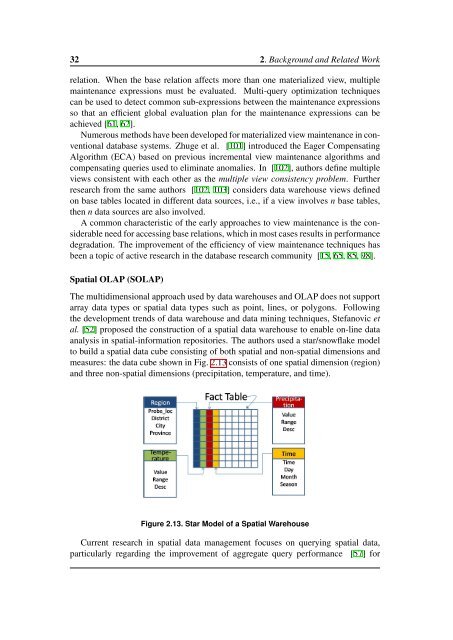Applying OLAP Pre-Aggregation Techniques to ... - Jacobs University
Applying OLAP Pre-Aggregation Techniques to ... - Jacobs University
Applying OLAP Pre-Aggregation Techniques to ... - Jacobs University
You also want an ePaper? Increase the reach of your titles
YUMPU automatically turns print PDFs into web optimized ePapers that Google loves.
32 2. Background and Related Work<br />
relation. When the base relation affects more than one materialized view, multiple<br />
maintenance expressions must be evaluated. Multi-query optimization techniques<br />
can be used <strong>to</strong> detect common sub-expressions between the maintenance expressions<br />
so that an efficient global evaluation plan for the maintenance expressions can be<br />
achieved [61, 62].<br />
Numerous methods have been developed for materialized view maintenance in conventional<br />
database systems. Zhuge et al. [101] introduced the Eager Compensating<br />
Algorithm (ECA) based on previous incremental view maintenance algorithms and<br />
compensating queries used <strong>to</strong> eliminate anomalies. In [102], authors define multiple<br />
views consistent with each other as the multiple view consistency problem. Further<br />
research from the same authors [102, 103] considers data warehouse views defined<br />
on base tables located in different data sources, i.e., if a view involves n base tables,<br />
then n data sources are also involved.<br />
A common characteristic of the early approaches <strong>to</strong> view maintenance is the considerable<br />
need for accessing base relations, which in most cases results in performance<br />
degradation. The improvement of the efficiency of view maintenance techniques has<br />
been a <strong>to</strong>pic of active research in the database research community [15, 65, 85, 98].<br />
Spatial <strong>OLAP</strong> (S<strong>OLAP</strong>)<br />
The multidimensional approach used by data warehouses and <strong>OLAP</strong> does not support<br />
array data types or spatial data types such as point, lines, or polygons. Following<br />
the development trends of data warehouse and data mining techniques, Stefanovic et<br />
al. [52] proposed the construction of a spatial data warehouse <strong>to</strong> enable on-line data<br />
analysis in spatial-information reposi<strong>to</strong>ries. The authors used a star/snowflake model<br />
<strong>to</strong> build a spatial data cube consisting of both spatial and non-spatial dimensions and<br />
measures: the data cube shown in Fig. 2.13 consists of one spatial dimension (region)<br />
and three non-spatial dimensions (precipitation, temperature, and time).<br />
Figure 2.13. Star Model of a Spatial Warehouse<br />
Current research in spatial data management focuses on querying spatial data,<br />
particularly regarding the improvement of aggregate query performance [57] for
















